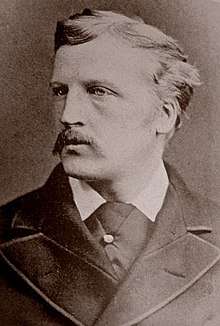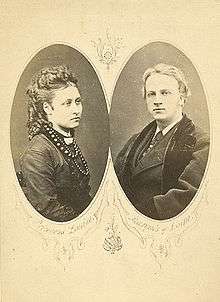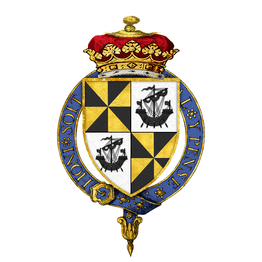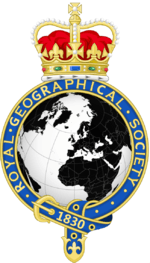John Campbell, 9th Duke of Argyll
| His Grace The Duke of Argyll KG KT GCMG GCVO VD PC | |
|---|---|
 | |
| 4th Governor General of Canada | |
|
In office 25 November 1878 – 23 October 1883 | |
| Monarch | Victoria |
| Prime Minister |
Canadian: Sir John A. Macdonald British: The Earl of Beaconsfield William Ewart Gladstone |
| Preceded by | The Earl of Dufferin |
| Succeeded by | The Marquess of Lansdowne |
| Personal details | |
| Born |
6 August 1845 London, United Kingdom |
| Died |
2 May 1914 (aged 68) Cowes, United Kingdom |
| Resting place | Kilmun Parish Church |
| Nationality | British |
| Political party | |
| Spouse(s) | |
| Parents | |
| Alma mater | |
John George Edward Henry Douglas Sutherland Campbell, 9th Duke of Argyll, KG, KT, GCMG, GCVO, VD, PC (6 August 1845 – 2 May 1914), usually better known by the courtesy title Marquess (Marquis) of Lorne, by which he was known between 1847 and 1900, was a British nobleman and was the fourth Governor General of Canada from 1878 to 1883. He is now remembered primarily for the place names bestowed on Canadian geography in honour of his wife and for his metrical paraphrase of Psalm 121, "Unto the hills around do I lift up".
Background and career
He was born in London, the eldest son of George, Marquess of Lorne and the former Lady Elizabeth Sutherland-Leveson-Gower, daughter of the 2nd Duke of Sutherland, and was styled Earl of Campbell from birth. In 1847, when he was 21 months old, his father succeeded as 8th Duke of Argyll and he assumed the courtesy title Marquess of Lorne, which he bore until he was 54. He was educated at Edinburgh Academy, Eton College, St Andrews and at Trinity College, Cambridge,[1] as well as at the National Art Training School.[2]
For ten years before coming to Canada, Lorne travelled throughout North and Central America, writing travel literature and poetry.[2] In the UK, he represented, from 1868, the constituency of Argyllshire as a Liberal Member of Parliament in the House of Commons. He made little impression there, however; the London World referred to Lorne as "a non-entity in the House of Commons, and a non-entity without."[2] A.C. Benson, who edited Queen Victoria's letters and spent time in the company of the royals, gave him the same epithet.[3]
Lord Lorne married Queen Victoria's fourth daughter, Princess Louise, on 21 March 1871. This was the first time a legitimate daughter of the sovereign had married a subject of the Crown since 1515, when Charles Brandon, the first Duke of Suffolk, married Mary Tudor.[4] The pair shared a common love of the arts, but the marriage was childless and unhappy, and they spent much time apart. Lorne formed close friendships with men, including Lord Ronald Gower, Morton Fullerton and the Count de Mauny, who were known to be homosexual or bisexual, which fuelled rumours in London society that he shared their predisposition. No conclusive evidence has been found.[5][2][6]
Governor General of Canada


When Lord Lorne's appointment was announced, there was great excitement throughout Canada. For the first time, Rideau Hall would have a royal resident. The Canadian Prime Minister relaxed his busy campaign schedule to prepare for her arrival and to organise a special carriage and corps of guards to protect the Princess. An author wrote in 1880 that "the appointment was hailed with satisfaction in all parts of the Dominion, and the new Governor General entered upon his term of office with the hearts of the people strongly prepossessed [sic] in his favour."[7]
However, Campbell and his wife were initially not received well by the Canadian press, which complained about the imposition of royalty on the country's hitherto un-regal society, a position that was only exasperated by mishaps and misunderstandings. The worries of a rigid court at the Queen's Canadian residence turned out to be unfounded;[8] the couple were more relaxed than their predecessors, as demonstrated at the many ice skating and tobogganing parties, balls, dinners, and other state occasions hosted by the Marquess and Marchioness.[9]
At age 33, Lord Lorne was Canada's youngest governor general, but he was not too young to handle the marginal demands of his post. He and Princess Louise made many lasting contributions to Canadian society, especially in the arts and sciences. They encouraged the establishment of the Royal Society of Canada, the Royal Canadian Academy of Arts, and the National Gallery of Canada, even selecting some of its first paintings. Campbell was involved in the completion of the Canadian Pacific Railway and other projects, such as a hospital for British Columbia.[2] In addition to acting as a patron of arts and letters in Canada, Lorne was the author of many books of prose and poetry. His writings show a deep appreciation of Canada's physical beauty.

Throughout his term of office, Lorne was intensely interested in Canada and Canadians. He travelled throughout the country encouraging the establishment of numerous institutions, and met with members of Canada's First Nations and with other Canadians from all walks of life. At Rideau Hall, he and Princess Louise hosted many social functions, including numerous ice skating and tobogganing parties as well as balls, dinners and state occasions. His small collection of First Nations artefacts was purchased by the British Museum in 1887.[10]
After Canada
Princess Louise returned to England in 1881 and Lord Lorne followed two years later in 1883, when his book, Memories of Canada and Scotland, was published.[11]
In 1907, strenuous efforts were taken by officials to ensure that Lorne's name was not dragged into the investigation of the theft of the Irish Crown Jewels. This was due to the fact that his closest friend was Lord Ronald Gower, who while innocent, was associated with several of the homosexual circle who were involved in it.[12][13]
Lorne was Governor and Constable of Windsor Castle from 1892 to 1914 and he sat as MP for Manchester South from 1895 until the death of his father on 24 April 1900, when he succeeded as 9th and 2nd Duke of Argyll. He and Princess Louise lived at Kensington Palace until his death from pneumonia in 1914. He is buried at Kilmun Parish Church.
Honours
- KG: Knight of the Most Noble Order of the Garter
- KT: Knight of the Most Ancient and Most Noble Order of the Thistle
- GCMG:Knight Grand Cross of the Most Distinguished Order of St Michael and St George
- GCVO: Knight Grand Cross of the Royal Victorian Order - 2 February 1901[14]
- LL.D. (honorary), University of Cambridge, May 1902
- Honorary Colonel of the 5th Volunteer Battalion, Princess Louise's (Argyll and Sutherland Highlanders), 20 September 1902.[15]
Places named after him
- Lorne Building, Ottawa, Ontario, Canada[16]
- Port Lorne, Nova Scotia, Canada
- Lorne, Nova Scotia
- Municipality of Lorne, Manitoba, Canada
- West Elgin, Ontario, Canada
- Lorne, Victoria, Australia
- Lorne Street, Oswestry, Shropshire, UK
- Lorne Street, Québec, Canada[17]
- Lorne Street, Sudbury, Canada[18]
- Marquis of Lorne Trail, section of Highway 22X, Calgary, Alberta, Canada
Ancestors
| Ancestors of John Campbell, 9th Duke of Argyll | |||||||||||||||||||||||||||||||||||||||||||||||||||||||||||||||||||||||||||||||||||||||||||||||||||||||||||||||||||||||||||||||||||||||||||||||||||||||||||||||||||||||||||||||||||||||||||||||||||||||||||||||||||||||||||||||||||||||||||||||||||||||||||||||||||||||||||||||||||||||||
|---|---|---|---|---|---|---|---|---|---|---|---|---|---|---|---|---|---|---|---|---|---|---|---|---|---|---|---|---|---|---|---|---|---|---|---|---|---|---|---|---|---|---|---|---|---|---|---|---|---|---|---|---|---|---|---|---|---|---|---|---|---|---|---|---|---|---|---|---|---|---|---|---|---|---|---|---|---|---|---|---|---|---|---|---|---|---|---|---|---|---|---|---|---|---|---|---|---|---|---|---|---|---|---|---|---|---|---|---|---|---|---|---|---|---|---|---|---|---|---|---|---|---|---|---|---|---|---|---|---|---|---|---|---|---|---|---|---|---|---|---|---|---|---|---|---|---|---|---|---|---|---|---|---|---|---|---|---|---|---|---|---|---|---|---|---|---|---|---|---|---|---|---|---|---|---|---|---|---|---|---|---|---|---|---|---|---|---|---|---|---|---|---|---|---|---|---|---|---|---|---|---|---|---|---|---|---|---|---|---|---|---|---|---|---|---|---|---|---|---|---|---|---|---|---|---|---|---|---|---|---|---|---|---|---|---|---|---|---|---|---|---|---|---|---|---|---|---|---|---|---|---|---|---|---|---|---|---|---|---|---|---|---|---|---|---|---|---|---|---|---|---|---|---|---|---|---|---|---|---|---|---|
| |||||||||||||||||||||||||||||||||||||||||||||||||||||||||||||||||||||||||||||||||||||||||||||||||||||||||||||||||||||||||||||||||||||||||||||||||||||||||||||||||||||||||||||||||||||||||||||||||||||||||||||||||||||||||||||||||||||||||||||||||||||||||||||||||||||||||||||||||||||||||
Notes
- ↑ "Campbell, John Douglas Sutherland, Marquess of Lorne (CMBL863JD)". A Cambridge Alumni Database. University of Cambridge.
- 1 2 3 4 5 Sandwell 2006, p. 47.
- ↑ Ward, Yvonne (2013). Unsuitable for Publication: Editing Queen Victoria. p. chapter 3 "It's Very Remarkable".
|access-date=requires|url=(help) - ↑ Stocker 2004, Louise, Princess, duchess of Argyll.
- ↑ Packard, Jerrold Victoria's Daughters, St Martin's Griffin, NY, 1998 pp. 203–205
- ↑ Rowse 1977, p. 157.
- ↑ Sandwell 2006, p. 48.
- ↑ Longford 1991, p. 45.
- ↑ Hubbard 1977, p. 125.
- ↑ "Collection search". British Museum. 20 March 2015. Retrieved 28 April 2016.
- ↑ The Marquis of Lorne (1883). Memories of Canada and Scotland. London, UK: Sampson Low, Marston, Searle & Riverton.
- ↑ Cafferky, John; Hannafin, Kevin Scandal and Betrayal: Shackleton and the Irish Crown Jewels, The Collins Press 2002, p. 112
- ↑ Trevelyan, Raleigh Princes Under The Volcano, William Morrow and Company, 1973, p. 338
- ↑ "No. 27285". The London Gazette. 15 February 1901. p. 1145.
- ↑ "No. 27475". The London Gazette. 19 September 1902. p. 6025.
- ↑ "Images of Centretown: Lorne Building, past, present and future". Centretown.blogspot.ca. 17 October 2009. Retrieved 28 April 2016.
- ↑ "Fiche descriptive". www.toponymie.gouv.qc.ca. Retrieved 2018-01-29.
- ↑ "Police investigating Lorne Street store robbery". Sudbury.com. 28 May 2018. Retrieved 31 May 2018.
References
- Cafferky, John; Hannafin, Kevin (2003). Scandal & Betrayal: Shackleton and the Irish Crown Jewels. Collins Press.
- Hubbard, R.H. (1977). Rideau Hall. Montreal and London: McGill-Queen's University Press. ISBN 978-0-7735-0310-6.
- Longford, Elizabeth (1991). Darling Loosy: Letters to Princess Louise 1856–1939. New York: Little Brown & Co. ISBN 978-0-297-81179-4.
- Rowse, A.L. (1977). Homosexuals in History. New York: Macmillan.
- Sandwell, R.W. (2006). "Dreaming of the Princess: Love, Subversion, and the Rituals of Empire in British Columbia, 1882". In Coates, Colin MacMillan. Majesty in Canada: Essays on the Role of Royalty. Toronto: Dundurn Press Ltd. p. 47. ISBN 978-1-55002-586-6. Retrieved 22 August 2011.
- Stocker, M. "Louise, Princess, duchess of Argyll (1848–1939)". Oxford Dictionary of National Biography (online ed.). Oxford University Press. doi:10.1093/ref:odnb/34601. (Subscription or UK public library membership required.)
- "No. 26353". The London Gazette. 13 December 1892. p. 7290.
External links
| Wikimedia Commons has media related to John Campbell, 9th Duke of Argyll. |
- Hansard 1803–2005: contributions in Parliament by Duke of Argyll
- Waite, P.B. (1998). "Campbell, John George Henry Douglas Sutherland, Marquess of Lorne and 9th Duke of Argyll". In Cook, Ramsay; Hamelin, Jean. Dictionary of Canadian Biography. XIV (1911–1920) (online ed.). University of Toronto Press.
- Website of the Governor General of Canada
- Works by John Campbell, 9th Duke of Argyll at Project Gutenberg
- Works by John Campbell, 9th Duke of Argyll at LibriVox (public domain audiobooks)

- Works by or about John Douglas Sutherland Campbell at Internet Archive
- Works by or about Duke of Argyll at Internet Archive
- "Archival material relating to John Campbell, 9th Duke of Argyll". UK National Archives.

- Photograph: Marquis of Lorne, Governor General of Canada in 1879. McCord Museum
| Parliament of the United Kingdom | ||
|---|---|---|
| Preceded by Alexander Finlay |
Member of Parliament for Argyllshire 1868–1878 |
Succeeded by Lord Colin Campbell |
| Preceded by Sir Henry Roscoe |
Member of Parliament for Manchester South 1895–1900 |
Succeeded by Hon. William Peel |
| Government offices | ||
| Preceded by The Earl of Dufferin |
Governor General of Canada 1878–1883 |
Succeeded by The Marquess of Lansdowne |
| Honorary titles | ||
| Preceded by Prince Victor of Hohenlohe-Langenburg |
Governor of Windsor Castle 1892–1914 |
Succeeded by The Marquess of Cambridge |
| Preceded by The Duke of Argyll |
Lord Lieutenant of Argyllshire 1900–1914 |
Succeeded by The Marquess of Breadalbane |
| Peerage of Scotland | ||
| Preceded by George Campbell |
Duke of Argyll 1900–1914 |
Succeeded by Niall Campbell |
| Peerage of the United Kingdom | ||
| Preceded by George Campbell |
Duke of Argyll 1900–1914 |
Succeeded by Niall Campbell |
